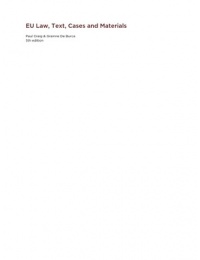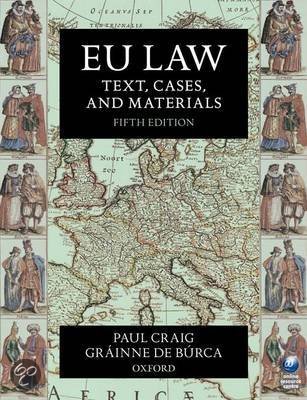EU Law, Text, Cases and Materials
Paul Craig & Grainne De Burca
5th edition
,Chapter 1, Development of European integration
I. Central issues
European Community = Consist of the European Coal and Steel Community (ECSC),
Atomic Energy Community (Euratom) and the Economic Community (EEC).
→ EEC was renamed the European Community after Maastricht
Lisbon Treaty, two constituent parts:
1. Treaty of European Union (TEU)
2. Treaty of Functioning of the European Union (TFEU)
Three themes should be borne in mind when surveying the development of the Treaties.
1. Distinction between institutional and substantive Treaty amendments
→ Institutional change connotes the relative power within the EU exercised by
the principal players. Can also impact on the EU’s power in relation to Member
States.
2. The way in which successive Treaty amendments have made significant changes to
the inter-institutional disposition of power within the EU, and to the substantive
areas over which it has competence.
3. Enlargement of the EU.
II. European integration: theories
Various phases in the development of European integration, several theories to explain
those phases, among which:
Functionalism = Belief that European integration would best be furthered by focusing
initially on discrete economic sectors, which could be managed efficiently and
technocratically by supranational institutions, away from the fray of politics.
→ Starts from the premise that by promoting functional cooperation among states it
may be possible to deter them from settling disputes over competition for scarce
resources aggressively.
→ Logic is to prevent war not negatively (by keeping states apart), but positively by
engaging them.
,Neofunctionalism share the same starting point, but sees integration as a process based
on spill-over from one initially non controversial, technical sector to other sectors of
possibly greater political salience, leading to a gradual reduction of national power
→ Neofunctionalism was challenged by the intergovernmentalist phase
(70’s), during which the supranational political Community institutions appeared to
lose initiative and influence, and the interests of individual Member States.
→ Neo-realism, neo-rationalism and liberal intergovernmentalism challenged
neofunctionalism by presenting states rather than supranational institutions as the
key actors in the integration process, seeking essentially to pursue their own
respective preferences and to protect their sphere of power.
In the 80’s the debate between supra/intergovern was questioned by literature, which
sees the EU as a system of multi-lever or network governance. Rather than focusing
debate principally on whether it is Member State governments or Europe’s supranational
institutions that drive the integration process, increased attention has been paid to the
wide range of actors and institutions involved at different levels in lawmaking and policy-
making within the European Union.
III. European integration: background
• WW II
• Statute on the Council of Europe (1949), providing or a Committee of Ministers and
a Parliamentary Assembly (creators ECHR).
• Schuman proposal – European Coal and Steel Committee
I. Common market, supranational (power to bind its constituent Member
States).
II. Institutions: High Authority, Assembly, Council, Court of Justice. High
Authority was supranational, but would sometimes be overruled by the
Council (which represented the interests of Member States).
III. First step towards European integration.
• Treaty of Maastricht (1992), founding European Union
,IV. EEC and Euratom treaties
A. EEC: founding and objectives
Committee chaired by Spaak, plans for Euratom and
European Economic Community (EEC), focus on economic. No temporal limit.
Primary Treaty objectives:
→ Common market
→ Approximate the economic policies of Member States, to promote harmonious
development of economic activities throughout the Community
→ Increase stability and raise standard of living
→ Promote closer relations between Members.
→ Trade barriers were abolished and a common customs tariff was to be
set up. Undistorted competition was to be ensured. Harmonization
(economic, monetary, fiscal and social policies).
→ EEC as a watchdog of the Treaties, initiator of legislation and negotiator of
international agreements on behalf of the Community.
→ Voting in the Council was weighted per size of a Member. Nature of the case
decided whether simple majority, qualified majority or unanimity was used.
B. Geographical reach of the Community
In 1950’s the UK had chosen to remain outside the EEC and instead in 1960 set up the
European Free Trade Association (EFTA) with six other States à Norway, Sweden,
Austria, Switzerland, Denmark, Portugal.
In 1961, The UK made it’s first application for Community Membership.
C. Community decision-making: intergovernmentalism and supranationalism
Geographic reach expanded between the EEC Treaty and the SEA, period was marked by
tensions between an intergovernmental view (De Gaulle, president of France) and a more
supranational view (Hallstein, Commission President). Surfaced in various ways:
Luxembourg Accords – 1965,
Tensions erupted into crisis when, under the provisions of the Treaty for the Council of
Ministers, was moved from unanimity to qualified majority voting. De Gaulle objected to
the ‘federalist logic’ of an important institutional reform proposal and France refused to
attend further Council meetings (empty-chair policy). Only after 7 months an accord was
reached.
→ Effects: French view prevailed, effect of pleading ‘very important interest’ was akin
to a veto, return to intergovernmentalism.
, Emergence of the EPC, European Council, and Comitology
Luxembourg Accords enhanced Members’ power by according states a de facto veto.
Also developments that enhanced Members’ power over decision-making. European
Political Council (1973), intergovernmental forum for cooperation of foreign policy.
Member states were able to impact on matters of political or economic
→ Concern; decisions of the EPC would normally constitute the frame within
binding Community initiatives would be pursued. Also greater control of
secondary legislation, through Comitology (committee system
which oversees the delegated,acts implemented by the European Commission)
Countervailing trends:
EP direct elections to the parliament were finaly argreed by the Member States. The first
elections took place in 1979.
In 1969 there was an agreement on funding by the own recourses en not from national
contributions.
V. Single European act
The 60s and 70s were considered to be the malaise of the Community, shown by several
reports that attested to the need for institutional reform and strengthening of the
supranational elements of the Community. In 1985 the Commission drew up a timetable
(‘White paper’) for the completion of the internal market. The SEA represented a political
commitment to this deadline by the Member States.
A. Institutional changes
→ Enhancement of the EP’s power in the legislative process, through the
‘cooporation’ procedure.
→ EP was given a veto over accession of new Members.
→ Legal basis for EPC and formal recognition to the European Council.
→ Comitology-procedure was formally included within what was art. 202 EC
B. Substantive changes
→ Internal market aim (art. 18 EC) and definition of internal market were set.
→ Qualified majority voting was brought back.
→ New art. 95 EC, principal Treaty provision for the enactment of measures to
complete the single market.
→ New substantive areas of Community competence.
C. Reaction and assessment
The changes created autonomous Community competence in the fields of regional policy,
environment and research.





